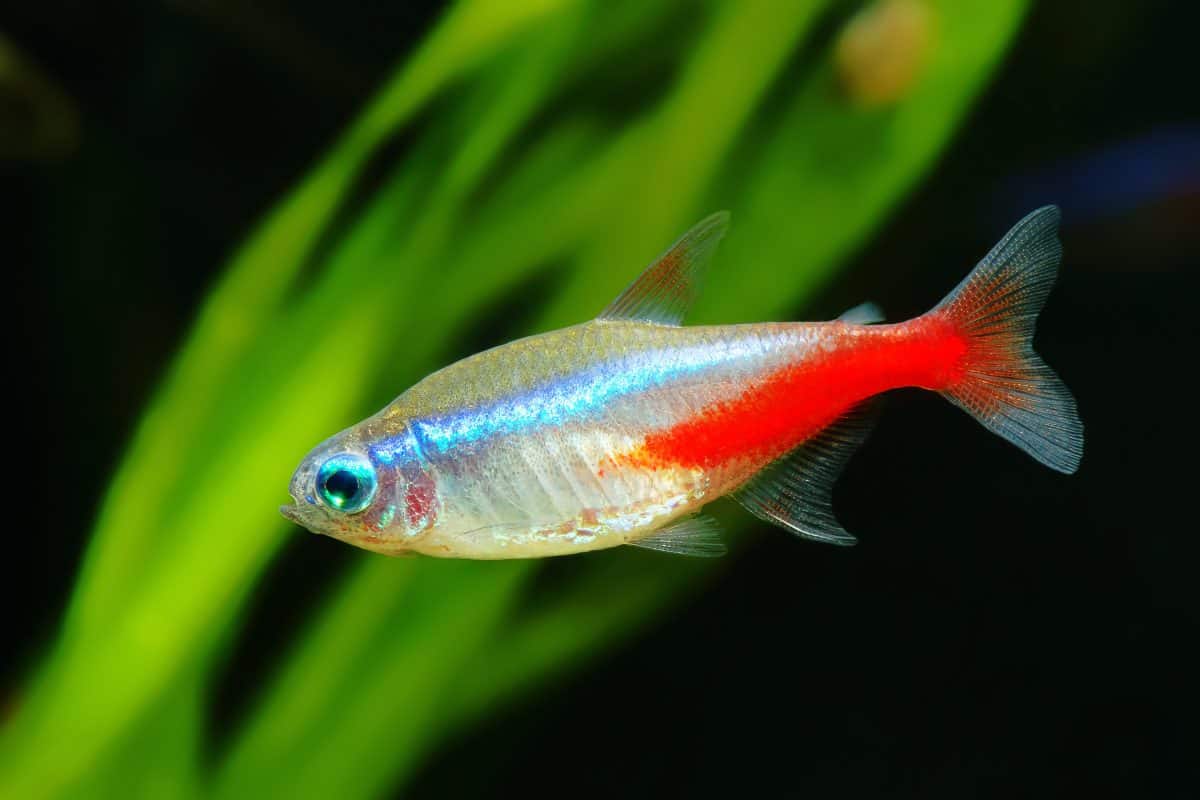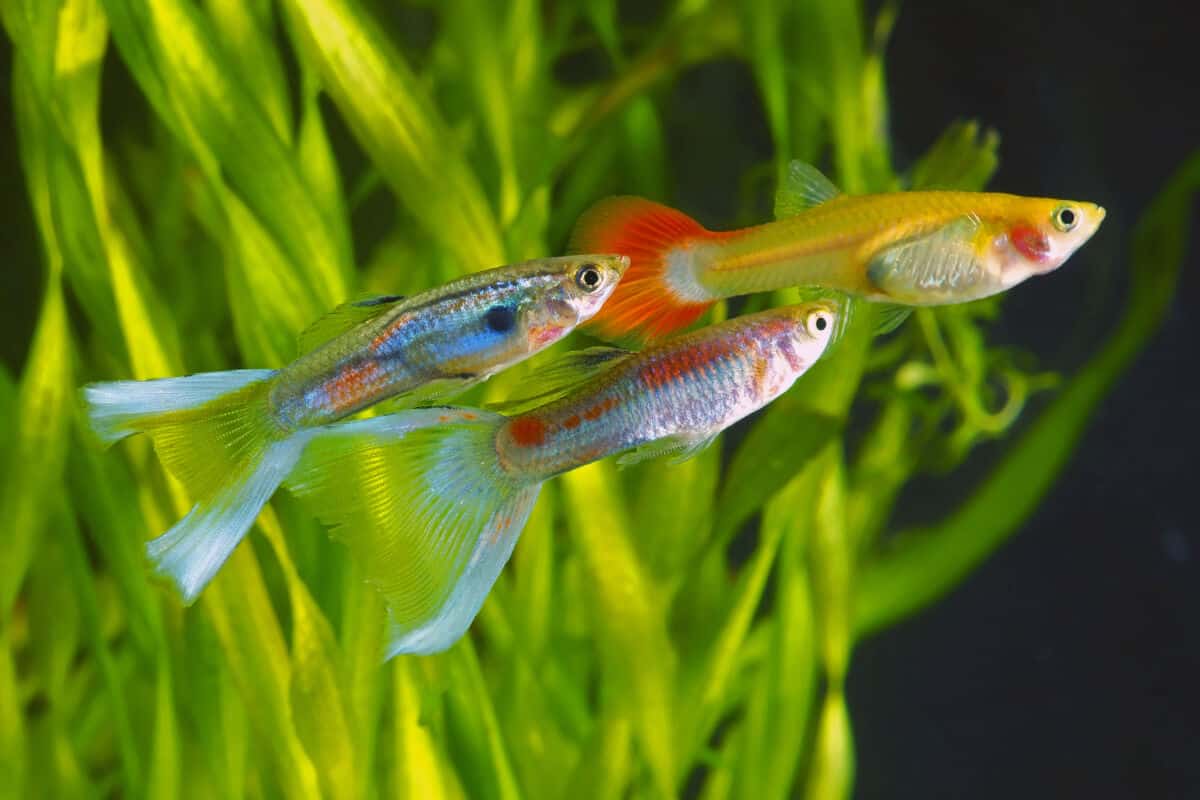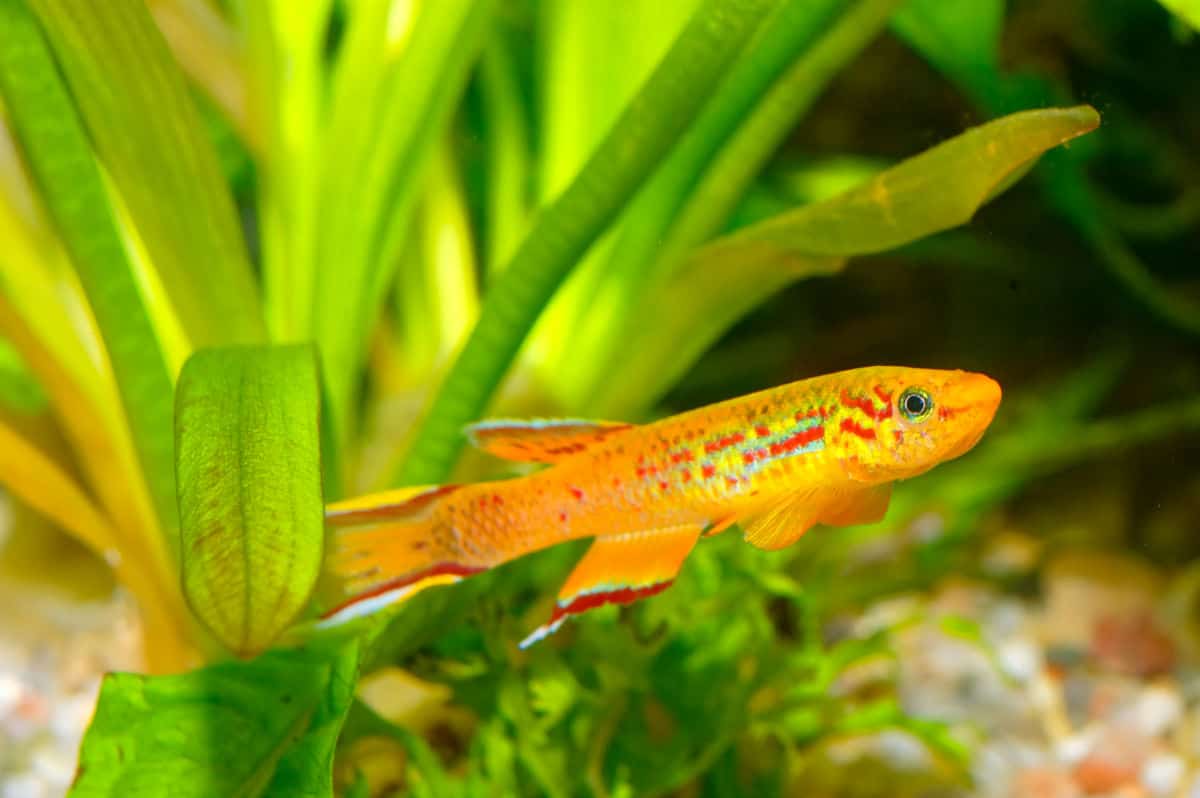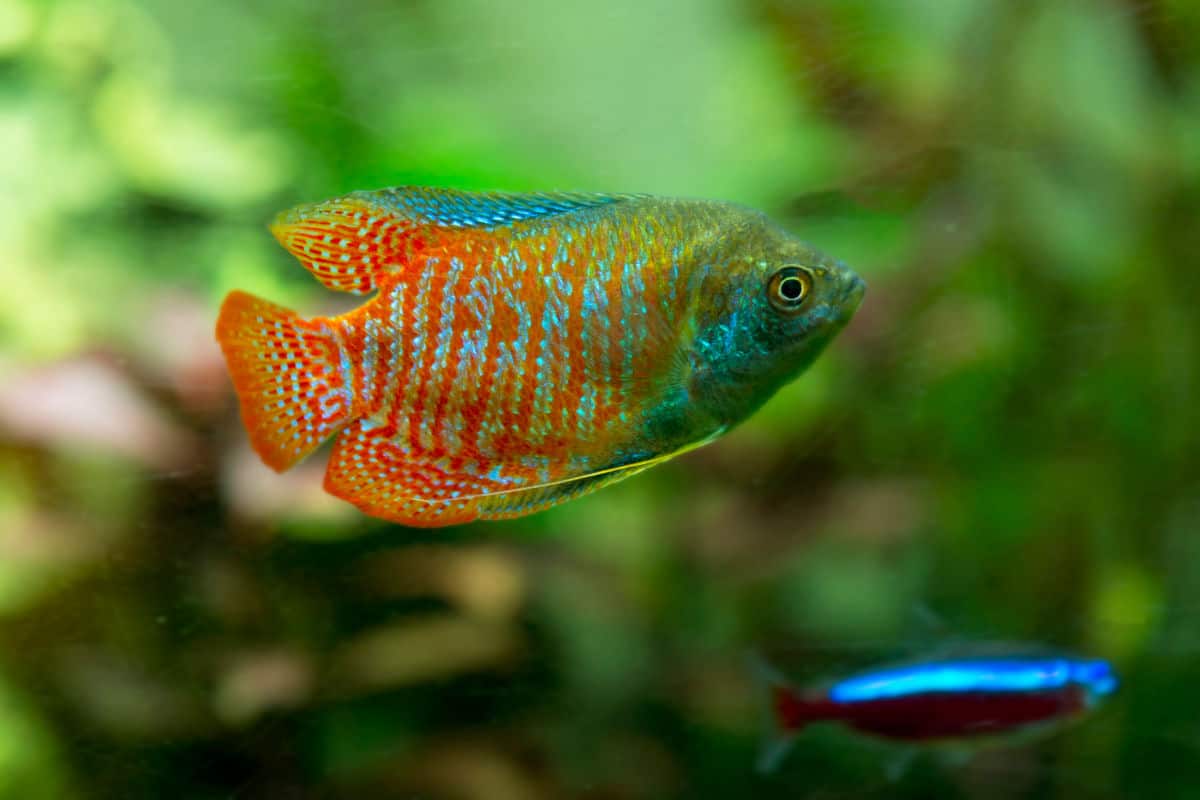The neon tetra, sometimes referred to as simply “neon,” is one of the most common fish to be found in an aquarium. Its bright colors and active movements make it a firm favorite with fish keepers.
Over 2 million of these fish are sold in the US each month. Most are imported from breeding farms in Southeast Asia or are wild caught in South America. First discovered in the early 1930s, they quickly gained popularity.
Best kept in schools of at least six, the fluorescent blue stripe makes this small species a great addition to any tank. Neon tetras are easy to keep and are a perfect choice for newcomers to tropical aquariums.
As with any fish, there is a learning curve when you first get them. In this article, we’ll discuss what you need to know to keep neon tetras in your home aquarium successfully.
Following a quick overview of essential facts and statistics, we will look at neon tetra care requirements, how to set their tank up, water parameter requirements, tankmate compatibility, and breeding of these fish.
By the end of the article, you will be able to decide whether their a good fit for you and your tank.
At a Glance: Overview of Facts and Statistics
We have compiled a table of the essential facts about neon tetras, giving you basic details at a glance.
| Characteristic | Details |
|---|---|
| Common name(s): | Neon, neon tetra |
| Scientific Name(s): | Paracheirodon innesi |
| Family: | Characidae |
| Origin: | South America, freshwater streams |
| Care Level: | Easy |
| Temperament: | Peaceful |
| Adult Size: | 1.25 inches on average |
| Color Form: | Blue, red |
| Lifespan: | 5 to 8 years |
| Minimum Tank Size: | 10 gallons |
| Typical Tank Setup: | Densely planted, with driftwood and rocks for refuge |
| Tank Level: | Mid-level to bottom |
| Diet: | Omnivore |
| Water Conditions: | Freshwater, 68-78° F, KH 4-8, pH 5.0-7.0 |
| Tank mates / Compatibility: | Small, peaceful, bottom-dwellers and other peaceful fish of a similar size |
The neon tetra was discovered accidentally, by adventurer Auguste Rabaut, a collector of fauna and flora. He was collecting butterflies in the Amazon when his attention was drawn to this brightly-colored fish.
He transported some to Europe and sold them for a large sum of money. Over the next few years, more neon tetras were brought out of the Amazon. The popularity of this colorful fish was born and remains to this day.
There are many different types of brightly colored tetra. These include the diamond tetra, golden tetra, cardinal tetra, and glowlight tetra. In this article, we’ll concentrate on the neon tetra and what it can offer your aquarium.
What Does a Neon Tetra Look Like?
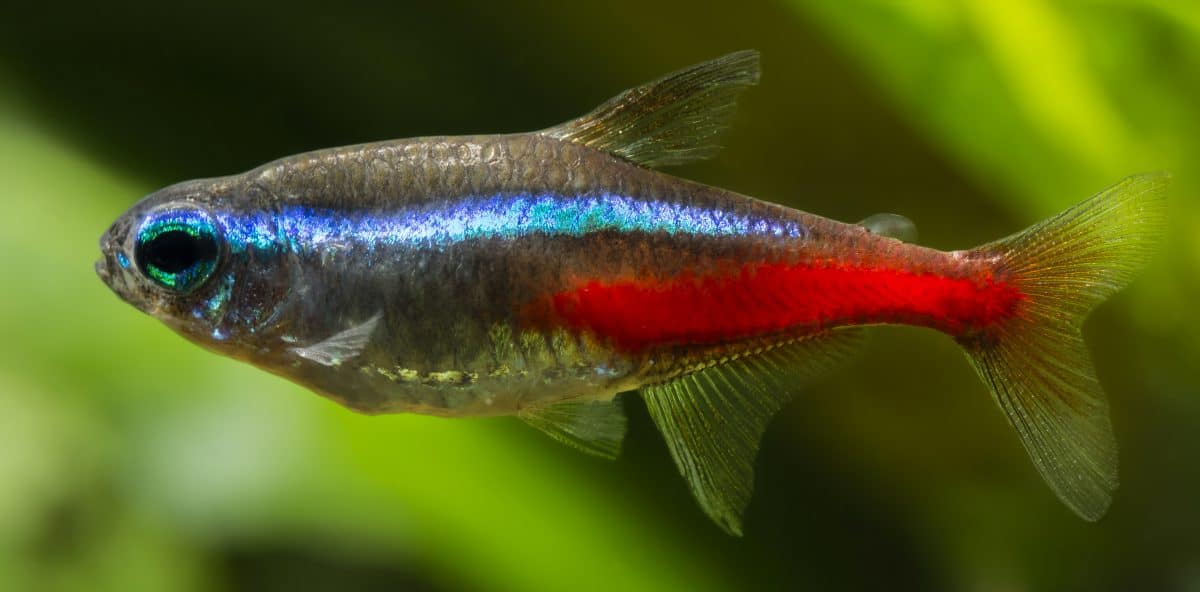
Their body is torpedo-shaped and slender. It grows to between an inch and 1.5 inches in length. The nose of the fish is rounded, and large eyes occupy most of the head.
Their color is quite spectacular. It has an iridescent blue stripe along the middle of the body, from nose to tail. This stripe is thought to act as a beacon to other members of the species in the wild, where water might not be clear.
Their belly is silvery white. A red stripe extends from the tail to about halfway along the belly, below the blue stripe, to the base of the caudal fin.
This stripe is also iridescent and further enhances the attractiveness of this tetra. Apart from these distinctive colored markings, the fish is translucent, including its fins.
When they become stressed, alarmed, or when resting at night, the colors fade. This also happens if the fish becomes ill. The ability to turn off these colors is also a defense mechanism, making them less visible to predators in their natural habitat.
Their average lifespan varies between five and eight years, although they have been known to live longer.
Differentiating between the sexes can be a challenge. The females present a slightly larger belly, and the iridescent stripe might be bent, whereas the male’s stripe is straight. It takes a trained eye to be able to spot these differences in such a slender, small fish.
What are Their Natural Behaviors?
These peaceful slow swimming fish mix well in the aquarium community. They will school when there are groups of six or more of them. You will find them swimming around between the mid-level and bottom of the tank.
When kept in small numbers, they will also school with other fish from the characin family, like cardinal tetras and green neon tetras. It’s not advisable to keep less than four together, otherwise they get stressed, go pale, stop swimming and eventually die.
Interestingly, many other species watch the behavior of neon tetras, using them as a spotter fish. When threatened, they will pack closely together in a school.
This behavior can encourage more timid tank mates to come out into the open area of the tank. They will watch the tetra and know when they need to hide. It’s also a good indicator for a fish keeper that they are settled and happy when they are well dispersed and swimming around.
What Sort of Tank and Habitat do They Need?
They are native to South America, where they are found in warm rivers, in Brazil, Peru, and Colombia. They are most concentrated in the Amazonian river basin.
They are usually found in slow-moving water tributaries to main rivers where they hang out in shoals midwater. There are forest canopies so dense they allow little light through to these black waters. This is probably why their neon colors are so bright so that fellow fish can find them in these dark conditions.
Almost all neon tetras are now bred in captivity in Eastern Europe and the Far East. Golden, diamond and long-finned neon tetras are captive-bred.
What Size Tank is Best?
The minimum size tank is 10 gallons. This is sufficient for a small school of six to 10 individuals. You should check out our guide to the best 10 gallon fish tanks for some inspiration and ideas on a suitable tank.
Idea Water Type and Parameters?
These freshwater fish prefer a temperature of between 68 and 78 degrees Fahrenheit. The pH level should be below 7.0 and above 6.0, and the KH between four and eight.
It’s worth noting that they might not survive in a newly cycled tank that hasn’t truly settled and stabilized. They are sensitive to fluctuations in water conditions.
This means you are better off adding tetras to a well-established, mature tank. Or one that has been ‘fishless cycled’ and been given time to stabilize.
In respect of water changes, 25 percent per week is the recommended amount.
What Substrate do They Like?
To mimic a river bed, the substrate should be dark in color. Use dark sand or small gravel, pebbles and rocks.
What Sort of Filters do They Need?
Their water should be “peat-filtered.” This will soften the water, which is preferred by this species.
They also like a little current to swim in midwater, which can be accomplished by using powerheads or canister filters that generate a moderate current for their water return outlets.
These fish are small, so make sure your filter intake can’t suck them in. Cover it with mesh or foam, to prevent accidents from happening.
What Lighting is Preferred?
To show off the iridescent coloring they have and to mimic their natural habitat, dim lighting is best. You can grow floating plants in your tank to provide areas of shade if needed.
What Decorations and Plants are Suitable?
Replicating a natural habitat, or biotope, for these fish is quite easy to put together. You can use river sand as a substrate, and plants with twisted roots. The addition of some driftwood will give them a place to hide.
Plants which hail from the Amazon river such as the Amazon sword plant (Echinodorus paniculatus) would be a good addition.
Adding a few dried leaves to the tank will stain the water light brown, similar to that of their river home. Remember to replace the leaves every few weeks, so they don’t break down and foul the tank water.
Leave some open spaces midwater so they can swim or suspend there. This will let them school together, displaying their beautiful colors.
How Many Neon Tetras Should You Have in a Tank?
The general rule for is one gallon of water per one inch of fish. So a 20-gallon tank is suitable for a community of 20. If you increase the numbers then increase the tank size by a gallon for each one.
What Should You Feed Them?
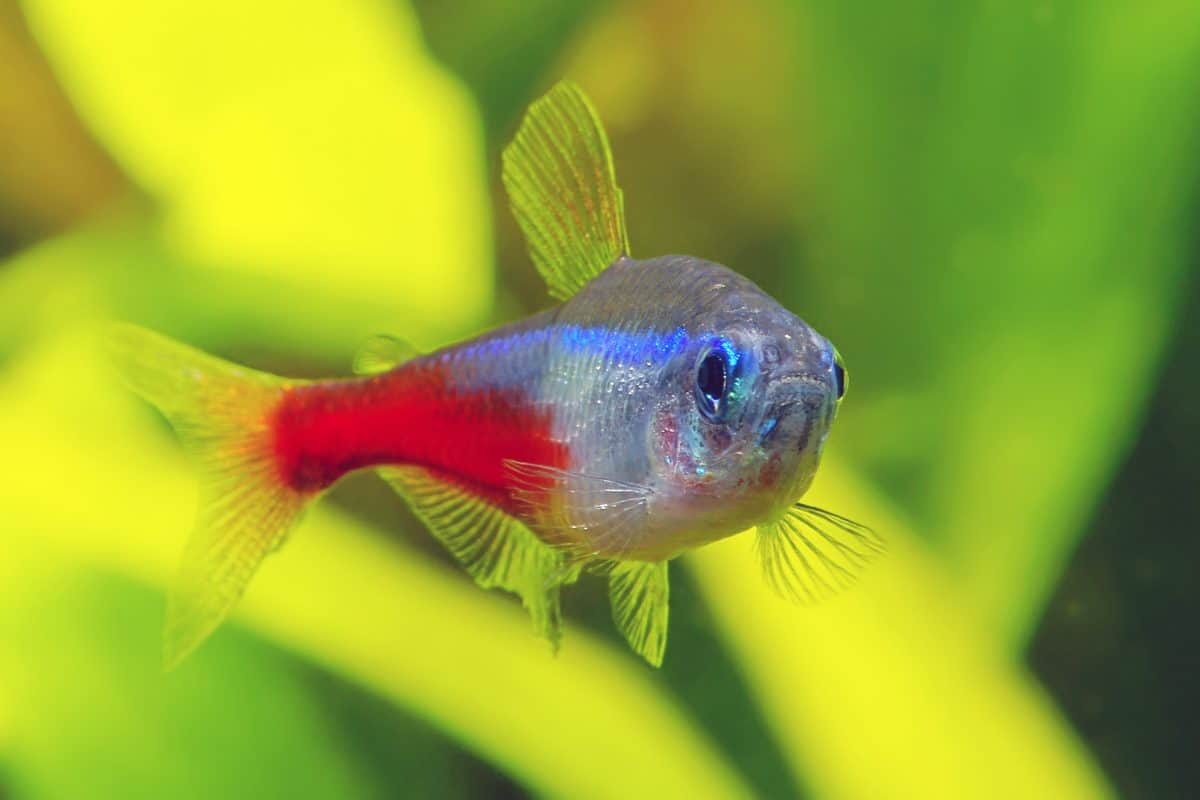
This omnivorous fish will eat meat, plants, and vegetables. They aren’t too fussy about what you put on their dinner menu and are easy to feed.
What Would They Eat in Their Natural Habitat?
Swimming about in the Amazon river the neon tetra will graze on algae. They will also eat insect larvae and other small invertebrates. They catch food midwater or pick it off the surface of the water, preferring not to feed off the bottom.
What Can You Feed Them in Your Home Aquarium?
Neon tetras should be fed a mix of meat or fish-based proteins and plants or vegetables. One study suggests that 45 percent of the diet should be from fish proteins for growth and health.
The basis for their diet should be a good quality flake or pellet. This can be supplemented with live feed, such as brine shrimp, bloodworms, tubifex or daphnia. Make sure you only feed them small pieces or finely-ground food.
Can Neon Tetras Eat any Human Food?
Small pieces of frozen peas which should be thawed and taken out of the shell can be fed. This might help their digestive health.
How Often Should You Feed Them?
They like to be fed a few times a day. When they are young, feed them twice a day, following the “three-minute rule.” This means let them eat what they can for three minutes only, and then stop feeding and remove uneaten food from the tank. This avoids overfeeding.
Once mature, feeding can be reduced to once a day, but still following the same method. It’s a good idea to skip feeding occasionally, having a ‘fast day’ to allow their digestive systems to sometimes empty out, and help ensure they don’t become overweight.
Any Special Care Requirements?
While neon tetra care is easy, they can suffer from a disease named after them, “Neon Tetra disease,” or Pleistophora. It is specific to this species and caused when the parasite, Pleistophora hyphessobryconis, is ingested from a dead or rotting organism.
Once this parasite is inside the intestines of the fish, the disease begins to eat the muscles. The disease is contagious, and any individual thought to have it should be removed from the tank immediately.
While rare, it’s possible for this condition to be passed on to other species. The symptoms include a curving of the spine, loss of normal color, bloating and swimming patterns which are not usual.
There is, unfortunately, no known cure for this disease. It is usually introduced to a tank from an infected fish. It’s therefore a good idea to quarantine any new fish before adding them to your aquarium, to make sure they are disease free before adding them into your community tank.
Which Fish are Friends for Neon Tetras?
These peaceful fish will get on well with many other smaller tropical species, particularly other tetras. They are sociable creatures and love to swim in schools.
Due to their small size, however, neon tetras are a perfect snack for larger fish. Make sure any fish you place in a tank with them have a mouth small enough not to be able to swallow them.
Good tankmates include:
- Livebearers such as guppies and mollies.
- Minnows such as the “white cloud.”
- Aquatic snails.
- Ghost shrimp.
- Bottom-dwelling fish such as the cory catfish.
Can You Keep More Than One Neon Tetra in a Tank?
This is a resounding “yes.” These sociable fish love the company of their own species and other tetras. They will school together and interact as they swim about the tank.
See them in action, how well they swim around together flashing their striking colors in this short video:
Buying Advice
TYou’ll find them available at almost any tropical aquarium outlet, or store with an online presence. They generally cost between one and two dollars per fish, but multiple purchases can be cheaper.
You can check out the price for these and many other tetras by using this link. Most neon tetras are now bred in Asia or Florida, and very rarely sourced from the wild.
Make sure the fish are displaying their colors and aren’t pale or faded. Many sellers include a few extra individuals when shipping, just in case some don’t survive the journey.
Can You Breed Them at Home?
Although neon tetras can be bred at home, this is considered quite difficult. You need to be meticulous about sterilizing the breeding tank and everything used in it. Soft, acidic water should also be used.
In rare cases, given ideal conditions, a breeding pair might spawn in the aquarium. The risk here is that the eggs will almost certainly be eaten, so a separate tank for breeding is a better option.
The breeding age for this fish begins when they are about nine months old. They can be bred in pairs or as a small school, with a minimum ratio of two females to each male.
The tank size for breeding should be one gallon for a pair or, for a school, up to 20 gallons. The water temperature for breeding should be 72–75 degrees Fahrenheit, the water softness between 1.0 to 2.0 dGH and the pH between 5.0 to 6.5.
Gentle water flow should be provided by a small sponge filter, which is air-powered. The substrate of the breeding tank needs to be about a half inch of rock or gravel, with some clumps of live plants which have a fine structure.
The lighting for the tank should be dark or very dim at first, gradually increasing the light to encourage spawning.
Another way to encourage breeding is by a 50 percent water change. This simulates a heavy rainfall in their natural habitat, and can encourage them to reproduce.
The female will produce up to about 130 clear eggs which will be scattered throughout the tank. It’s essential to remove the parents after spawning, otherwise they will eat the eggs.
Lighting should be kept dim, as both eggs and fry are photosensitive. Once hatched, the fry should be fed on infusoria until they’re big enough to eat baby brine shrimp or small pieces of bloodworm. It will take about a month for the fry to develop the recognizable vibrant neon tetra colors.
Interesting Facts and Trivia
Here are a few fun facts and tidbits about neon tetras:
- They belong to the same family of fish as piranhas.
- The first neon tetras imported into France in 1934 were sold for $6500.
- Accompanied by a human companion, neon tetras took a trip on the Hindenburg in 1936. Only one of the five fish being brought to Chicago survived.
- It is estimated that about two million individuals are imported into the US yearly.
- There are about 150 other species of tetra.
- They are one of the most commonly bred fish for commercial sale.
Frequently Asked Questions
What do Neon Tetra Eggs Look Like?
The eggs from these fish are tiny and yellowish white in color. You may find some in your tank if they don’t get eaten. This video shows eggs being released by a black neon tetra.
Do They Eat Their Babies?
They will eat the eggs they lay, therefore it’s essential to remove adults from a breeding tank after spawning. If you notice eggs in the main tank and want to see if fry will emerge, then they need to be removed to a juvenile tank.
How Can I Tell if a Neon Tetra is Pregnant?
They are egg layers; a bloated belly might indicate a fish is carrying eggs, or it could be constipated. Check out how the males are behaving towards her. If they are “dancing” around her, she could be carrying eggs.
Can I Keep Neon Tetra With a Betta?
They generally hang around the mid-tank area and will keep their distance from a betta. As a result, they can get along. It might be worth feeding your betta first at dinner time, though, to prevent any aggressiveness.
Can I Keep Them in a Five Gallon Tank?
The rule of thumb is one gallon of water for each inch of fish and, while they start out small, they can grow to 1.5 inches long. Since they like to school, it’s ideal to keep six or more for them to do well. To keep them comfortable, you really need a 10-gallon tank or bigger.
How Do They Get Their Glow?
These fish, and others like them that have an iridescent glow, have cells in their body called “iridophores.” These cells have guanine crystals which can reflect light and make certain colors appear brighter when it hits them.
The iridophores can expand when there is light present and contract when it’s dark. Hence the bright blue color of neon tetras in daylight and pale green colors in the dark, or dim light of morning.
These color changes can act as beacons for other neon tetras in the natural blackwater habitat of the Amazon river. It lets stray fish know where the school is.
Is a Neon Tetra the Right Fish for You?
One of the most popular aquarium fish, neon tetra care is easy. Sought after for their striking, iridescent blue and red stripe, these peaceful fish are best kept in small schools.
They will swim or suspend themselves midwater in a tank, giving a wonderful bright display. A minimum tank size of 10 gallons will house a school of about 10 of these fish. They don’t like to be alone, so make sure they have other neon tetras for company.
They can breed in a home aquarium, but setting up a separate breeding tank will be an absolute neccessity. They are also cannibalistic of their eggs, so make sure they are removed after spawning.
The neon tetra is suitable for newcomers to fish-keeping or experts alike.
We hope you found our neon tetra care guide useful, and enjoy gazing at yours as they light up your tank. If you have anything you would like to share or questions to ask, please do leave us a comment below, we will answer every comment.
Happy fish keeping!

